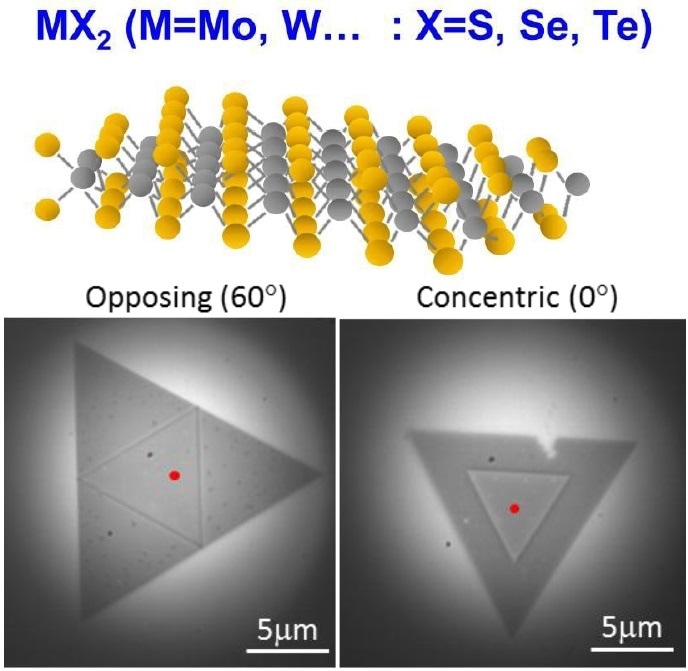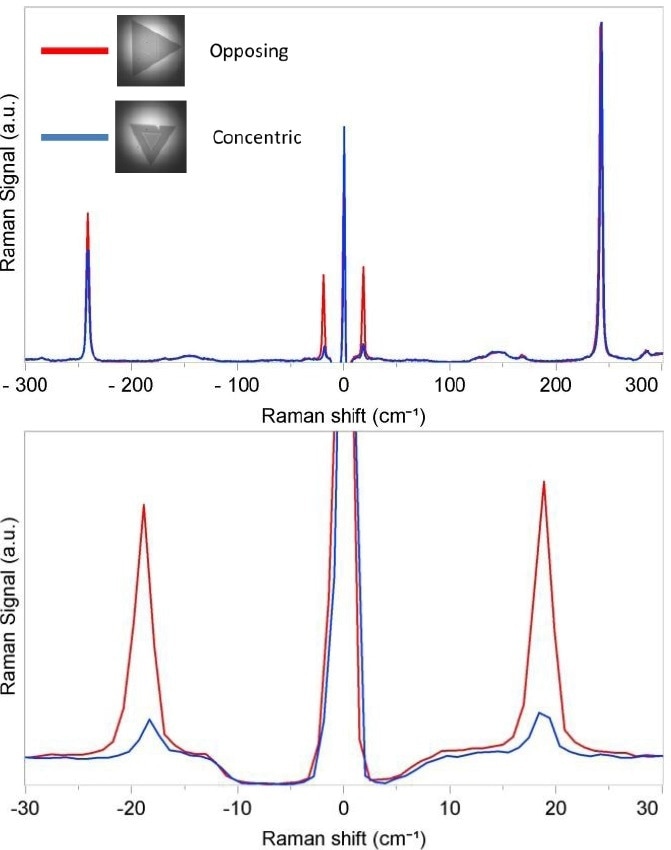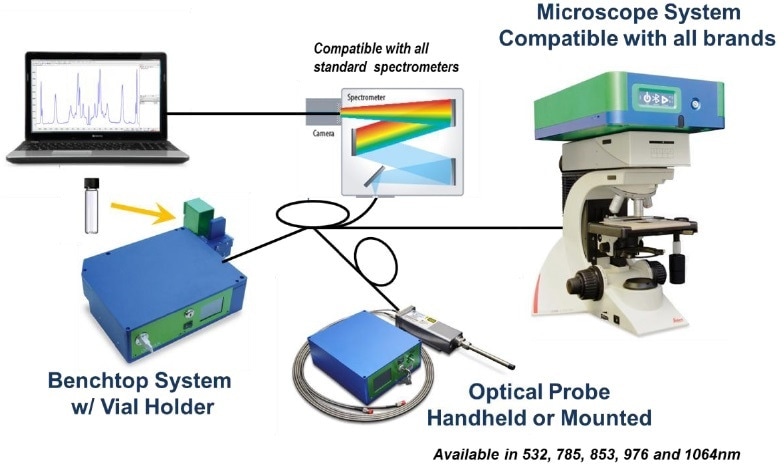The properties of few-layered materials are significantly different when compared to their bulk phase. Their tunable optoelectronic characteristics are largely governed by the interactions between the vertically stacked layers, and are affected by the number and orientation of the layers.
The vibrations corresponding to these interlayer interactions, known as shear modes, manifest as low frequency Raman peaks very close to the laser Rayleigh line, which are not detected by traditional Raman spectroscopy. However, the use of low frequency/THz-Raman® facilitates the measurement of shear modes for transition metal Dichalcogenide (TMD) materials, allowing unambiguous and clear measurement of the orientation as well as the number of layers.

Figure 1. Generalized chemical structure of TMDs, showing the metal (grey) and chalcogenide (yellow) atoms , adapted from S. Mouri, K. Matsuda et al., Nano Lett. 13, (2013) 5944. (Top) and Optical Micrographs (100x) of two layer MoSe2 substrates. Red dot indicates the approximate location of the Raman measurement (Bottom).†
†The MoSe2 sample was synthesized and characterized at the Center for Nanophase Materials Sciences at Oak Ridge National Laboratory (X. Li, A.A. Puretzky; see ACS Nano 9, 6333-6342 (2015) for details).
The THz-Raman® Solution
The advent of THz-Raman® system has extended the range of conventional Raman spectroscopy to the THz/low frequency Raman regime, where lattice modes correlating to the material structure are found and inter-layer modes can be clearly and quickly observed. While the traditional Raman spectra might hint at similar information, they are usually indirect and not easily verified using ab-initio simulations.
This article discusses the study of a sample of MoSe2 with a distribution of two different relative orientations of the two layers (Figure 1). An Coherent TR-MICRO-532 THz-Raman® system coupled to a single-stage spectrometer with a spectral resolution of 1.5 cm-1 was used to collect the Raman spectral data, using excitation at 532 nm. Figure 2 shows the normalized THz-Raman® spectra of the two orientations of MoSe2.

Figure 2. Normalized THz-Raman® spectra of two-layer MoSe2 materials showing the corresponding shift and change in magnitude of the peak corresponding to the bulk mode at 242 cm-1 (Top) and the shear mode peak at 18 cm-1 (Bottom)
THz-Raman® Analysis
The Raman spectra shown in Figure 2 demonstrate that irrespective of orientation, both the two-layer MoSe2 materials display an out-of-plane bulk mode as a peak at 242 cm-1 in the Raman spectrum. The single layer MoSe2 does not show the shear modes at 18 cm-1.
On the other hand, for the two-layer MoSe2 case, a shear mode peak is present at 18.9 cm-1, as determined by a center of mass analysis. When the MoSe2 layers are oriented to be concentric, a large change in the intensity of the peak and a bathochromic shift to 18.4 cm-1 are observed. This shows that direct information about the orientation and number of the layers in 2D materials can be provided by THz-Raman® spectroscopy.
Atomic force and scanning tunneling microscopies can be employed to establish the exact atomic registration between different layers. However, they are slow techniques and demand expensive instrumentation and off-line analysis. THz-Raman® offers a fast, cost-effective and non-destructive solution for fast prototyping of two dimensional materials.
Features
- Simultaneous chemical and structural analysis
- Sensitivity to defects and dopants in the 2D material structure
- Direct correlation of orientation with peaks positions and magnitude
- Quantitative analysis number of layers
- Direct measurement of inter-layer vibrations in few-layered materials
- Directly calculate THz-Raman® spectra using ab-initio calculations

Conclusion
Coherent’s patented THz-Raman® spectroscopy systems have extended the range of conventional Raman spectroscopy into the THz/low-frequency regime. As a result, simultaneous analysis of both chemical composition and molecular structure for sophisticated materials characterization can be achieved. All THz-Raman® systems are robust, compact and plug-and-play platforms that offer extraordinary speed, throughput and ease of use, all at an affordable price. With a broad range of sample interfaces, wide selection of excitation wavelengths from 488 nm to 1064 nm, and optional polarization control, there is a THz-Raman® solution that can be used successfully for any application.

This information has been sourced, reviewed and adapted from materials provided by Coherent.
For more information on this source, please visit Coherent.